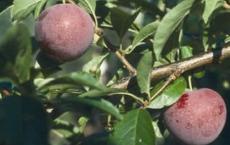- Related plum trees categories:
- European plums8
Japanese plums
Japanese plums, from the species Prunus salicina, originate from the Far East, including China and Japan. They were imported to North America in the late 19th century via Japan and became known as Japanese plums.
While European plums tend to do best in cooler climates, Japanese plums proved to be very well-suited to the hotter climates of much of the United States, particularly California.
Japanese plums are very productive and easy to grow. The plums are usually a bit larger than the European species, and are primarily grown for eating out of hand.
Most Japanese plums are not self-fertile, however most flower at the same time so cross-pollination is easily achieved simply by planting two different Japanese plums near to each other There are some exceptions, which are noted in our variety pages.
Japanese plums flower before European plums and are not compatible for pollination purposes.
AU Rosa
AU Rosa is a heavy-cropping and self-fertile red plum, related to the popular Santa Rosa but with better disease resistance.- Picking season: Mid
- Gardening skill: Average
- Self-fertility: Self-fertile
- Pollination group: 1
Methley
Methley is an early-season Japanese plum. It is reliably self-fertile, and crops heavily from a young age.- Picking season: Early
- Gardening skill: Average
- Self-fertility: Self-fertile
- Pollination group: 1
Santa Rosa
Santa Rosa is the definitive Japanese plum, with dark red skin and a sweet rich flavor.$41.95buy- Picking season: Mid
- Gardening skill: Average
- Self-fertility: Self-fertile
- Pollination group: 1
Toka
Toka is a cold-hardy Japanese-style plum, also known as Bubblegum on account of its sweet fruity flavor.- Picking season: Late
- Gardening skill: Average
- Self-fertility: Not self-fertile
- Pollination group: 2

